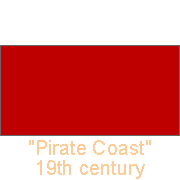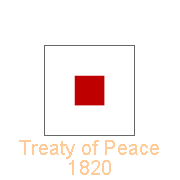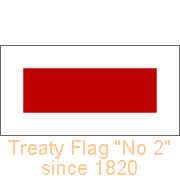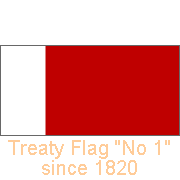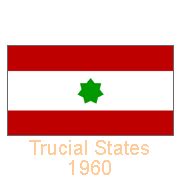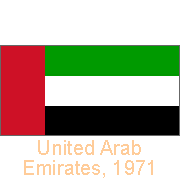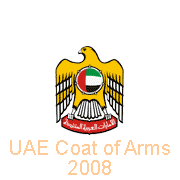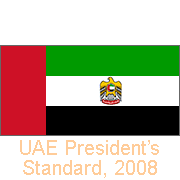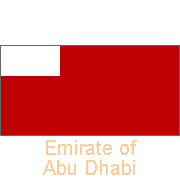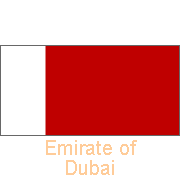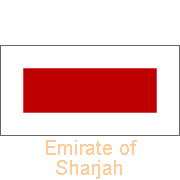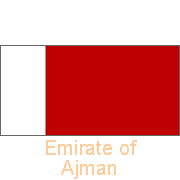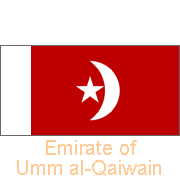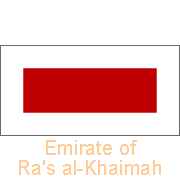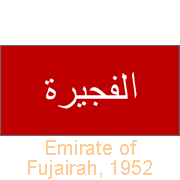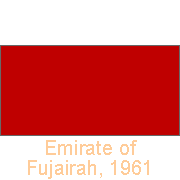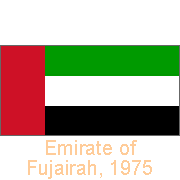Flags from United Arab Emirates
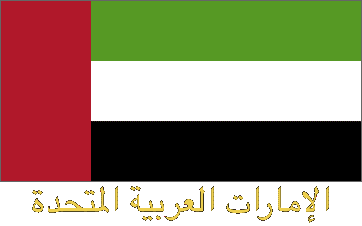
A Flag history of the United Arab Emirates
The disparate sheikhdoms of the Gulf and in Oman traditionally all flew plain red flags. When the British, based in India, concluded an agreement with the Omani-based Al-Busaid clan, they provoked the hostility of their rivals, the Qawasim clan, based in Sharjah and Ra's al-Khaimah. From there on British vessels were constantly attacked and pillaged by vessels of the Qawasim, so in the early 19th century this stretch of coast became known as the "Pirate Coast".
you may then send it as a postcard if you wish.
In 1819 the British dispatched a large fleet and within a year they had destroyed and captured every Qawasim ship that it had come across and occupied all the major forts in the area, including Ra's al-Khaimah. Then in 1820 the British imposed a General Treaty of Peace on all nine Arab sheikhdoms along this coast and prescribed them to fly a square "white pierced red" flag instead of the plain red flags they were using on their vessels. The white in the flag would signify they had abandoned piracy. That flag was however not acknowledged by all tribes, who changed the designs and proportions.
The Qawasim, who had been the principal leaders of the Persian Gulf pirates from the early 18th century, adopted the prescribed square "white pierced red" flag, but, as the Arab tribes preferred very long flags on their ships, they flew flags with proportions of 1:3, 1:4, or even 1:6. This flag, called the "No. 2 flag", also became known as the "Qasimi" (singular of Qawasim) flag. This flag however was not acknowledged by all tribes because it was associated with the Qawasim dynasty of Sharjah. The other tribes then added a white stripe to their plain red flag at the hoist. This was called the "No. 1 flag", although it was introduced after the "No. 2" or "Qasimi" flag. Although the British required vessels to include the colour white in their flags after the treaty to indicate they had forsaken piracy, the plain red flag continued to be flown on land. The treaty with the British was in 1835 upgraded to the "Maritime Truce" in which sheikhs agreed to stop all hostilities at sea and this was further revised in 1839 and 1853. Because of this, the area became known as "Trucial Oman" or the "Trucial Coast".
In 1960 the Trucial States Council was formed; its flag, with the traditional red and white, included a green seven-pointed star, for the 7 sheikhdoms. Originally a flag was proposed with a nine-pointed star, as it was hoped that Qatar and Bahrain would also join the federation; this did not happen, so the flag only had seven points. In 1971 the Trucial States Council terminated the defence treaties with the United Kingdom and established a six-member federation; Ra's al-Khaimah joined the following year. The National or Federation flag that was adopted on 2 December 1971 displayed the Pan-Arabic colours, as is found in most flags of the Middle East.
In 1973 a coat of arms was adopted for the United Arab Emirates, displaying a golden falcon with a red disk, featuring a “dhow”, an Arab sailing boat, surrounded by a chain. The falcon held in its talons a red scroll with the name of the federation in Kufic script. That same year a President's standard was adopted: the national flag with the country's emblem on the white stripe. On 22 March 2008, the emblem was changed: the dhow was replaced by the flag of the UAE, surrounded by seven stars, representing the seven Emirates of the federation. The President's standard was changed accordingly.
With the formation of the United Arab Emirates the flags of the separate sheikhdoms or emirates are no longer much in evidence; only Dubai displays it quite often, together with the Federation flag. The other emirates seem to fly it only from their old forts, now converted to museums, while Fujairah has given up its old red flag altogether and adopted the UAE flag as its regional flag too.


